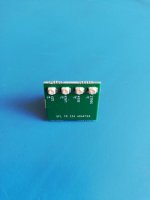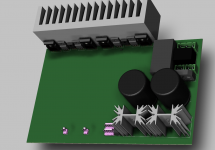Lateboomer,
Though it should be responded by Sonny, and he will for sure give You the correct answer, let me try to express the impression that I get about your 'quest'.
The I2S input is an auxiliary input in that V1.2a dac modul. It is getting through the SRC chip, asynchronous reclocking. It must be so because the dac core is always running from it's own, high quality fixed frequency clock. The external I2S signal is existing in it's own, independent clock domain. To synchronise these two clock domains one has to do something, and Sonny had opted for the texas SRC4392 chip.
So your I2S signal first enter the a-synchronous reclocker, gets resampled and finally gets re-clocked by the local, high quality clock.
So do not worry about the I2S signal path quality.
It cannot be maintained at the same ultimate level as the USB input path is handled.
For getting the maximum treatment for external I2S signals, a better option is a new dedicated dac only for this kind of application. That would come ! without any local clock, You the user should take care of clock quality, signal integrity, etc. Sonny offered this solution earlier on.
https://www.diyaudio.com/forums/ven...4490-usb-dac-dsd-support-193.html#post5791639
So I would suggest: just use Sonny's dac in it's best, maximally optimized (as originally intended) form.
If you wish, insist on in taking into your own hand the handling of the input data path & and providing an external high quality clock - (possibly controlled through measurements, so as to be aware of any problems maybe getting into the picture..) then there are other solutions, one of these could be the above offer of Sonny.
If you can convince him doing it..
Reassuming: in my opinion, the path You would like to follow is reasonable, but it is not realizeable contemporarily in the same dac topology. If You wish direct I2S input, you need a Dac without local clocking.
A different structure. The designer of such a 'dac hat' had given up on fully controlling the final quality, it is totally up to the user and his actual realization.
Sonny offers a complete solution, fully controlled &guaranteed quality by him- but not promptly re-configurable for maximum quality for a signal with external, independent clock domain.
The two clock domains must be synchronized somehow..
Ciao, George
Ciao, George
Though it should be responded by Sonny, and he will for sure give You the correct answer, let me try to express the impression that I get about your 'quest'.
The I2S input is an auxiliary input in that V1.2a dac modul. It is getting through the SRC chip, asynchronous reclocking. It must be so because the dac core is always running from it's own, high quality fixed frequency clock. The external I2S signal is existing in it's own, independent clock domain. To synchronise these two clock domains one has to do something, and Sonny had opted for the texas SRC4392 chip.
So your I2S signal first enter the a-synchronous reclocker, gets resampled and finally gets re-clocked by the local, high quality clock.
So do not worry about the I2S signal path quality.
It cannot be maintained at the same ultimate level as the USB input path is handled.
For getting the maximum treatment for external I2S signals, a better option is a new dedicated dac only for this kind of application. That would come ! without any local clock, You the user should take care of clock quality, signal integrity, etc. Sonny offered this solution earlier on.
https://www.diyaudio.com/forums/ven...4490-usb-dac-dsd-support-193.html#post5791639
So I would suggest: just use Sonny's dac in it's best, maximally optimized (as originally intended) form.
If you wish, insist on in taking into your own hand the handling of the input data path & and providing an external high quality clock - (possibly controlled through measurements, so as to be aware of any problems maybe getting into the picture..) then there are other solutions, one of these could be the above offer of Sonny.
If you can convince him doing it..
Reassuming: in my opinion, the path You would like to follow is reasonable, but it is not realizeable contemporarily in the same dac topology. If You wish direct I2S input, you need a Dac without local clocking.
A different structure. The designer of such a 'dac hat' had given up on fully controlling the final quality, it is totally up to the user and his actual realization.
Sonny offers a complete solution, fully controlled &guaranteed quality by him- but not promptly re-configurable for maximum quality for a signal with external, independent clock domain.
The two clock domains must be synchronized somehow..
Ciao, George
Ciao, George
Seriously:
If You already have a different DDC, or FIFO system from Ian, and would like to integrate into a dac that: then a different system, like a dac hat, or something like diyinhk bare dac board is maybe a better approach.
Sonny's dac is best tried in it's integrity. One also can tweak it, as I do with the V1.0, only USB version. But always as a complete unit, digital receiver / dac with clock and high quality local power supplies.
The results can be seriously good both sonically and measurably. See my latest graphs. They show that a Mirand dac can be as much "Blameless" as far as it gets..
In fact the results are competing with semi professional analyzers.
Then, do not forget that also the mivera board, the first and popular one was entirely produced by Sonny - under a different name. And the base design was still that of the mirand V1.0....
With tweaks. (Like I'm doing)
Ciao, George
If You already have a different DDC, or FIFO system from Ian, and would like to integrate into a dac that: then a different system, like a dac hat, or something like diyinhk bare dac board is maybe a better approach.
Sonny's dac is best tried in it's integrity. One also can tweak it, as I do with the V1.0, only USB version. But always as a complete unit, digital receiver / dac with clock and high quality local power supplies.
The results can be seriously good both sonically and measurably. See my latest graphs. They show that a Mirand dac can be as much "Blameless" as far as it gets..
In fact the results are competing with semi professional analyzers.
Then, do not forget that also the mivera board, the first and popular one was entirely produced by Sonny - under a different name. And the base design was still that of the mirand V1.0....
With tweaks. (Like I'm doing)
Ciao, George
Joseph K,
A few questions regarding your post. If I am using a raspberry pi for streaming, will the best quality sound be achieved by going USB (raspberry pi) to USB (Sonny's DAC), as opposed to I2S to I2S? Is this correct?
I was thinking of using I2S to I2S but it sounds like I would not be getting the full potential from the DAC. I was also thinking of using RPI I2S -> FifoPi -> I2S DAC, but even that would be a step down from the ultimate USB path. Is this correct?
Thanks in advance for your advice.
Best Regards, Todd
A few questions regarding your post. If I am using a raspberry pi for streaming, will the best quality sound be achieved by going USB (raspberry pi) to USB (Sonny's DAC), as opposed to I2S to I2S? Is this correct?
I was thinking of using I2S to I2S but it sounds like I would not be getting the full potential from the DAC. I was also thinking of using RPI I2S -> FifoPi -> I2S DAC, but even that would be a step down from the ultimate USB path. Is this correct?
Thanks in advance for your advice.
Best Regards, Todd
Seriously:
If You already have a different DDC, or FIFO system from Ian, and would like to integrate into a dac that: then a different system, like a dac hat, or something like diyinhk bare dac board is maybe a better approach.
Sonny's dac is best tried in it's integrity. One also can tweak it, as I do with the V1.0, only USB version. But always as a complete unit, digital receiver / dac with clock and high quality local power supplies.
The results can be seriously good both sonically and measurably. See my latest graphs. They show that a Mirand dac can be as much "Blameless" as far as it gets..
In fact the results are competing with semi professional analyzers.
Then, do not forget that also the mivera board, the first and popular one was entirely produced by Sonny - under a different name. And the base design was still that of the mirand V1.0....
With tweaks. (Like I'm doing)
Ciao, George
I also owned one Allo Usbridge, so I will use it with Mirand dac to see how good it is. I ordered an IsolatorPi from Ian to use it with Allo Boss dac hat. I will also tap the i2s output from isolatorPi to Mirand dac to test how good it is compared with Usbridge.
Hey George,
Bit of a bad news but.. USBridge very often have drop-off from Dac. Allo stated they could not help it because its sbc dependant, and only compatible sparky. The processor manufacturer have no interest to update kernel. USBridge works flawless with a handful of Dac only. But I can tell you sound is a++
Sonny, does i2s works with allo kali? I2s reclocked. Much easier for me to get it
Would be nice to be able add an rpi easily for full streaming hardisk capabilities. Already reclocked. I don't really care about high bit dsd. But that's me
Bit of a bad news but.. USBridge very often have drop-off from Dac. Allo stated they could not help it because its sbc dependant, and only compatible sparky. The processor manufacturer have no interest to update kernel. USBridge works flawless with a handful of Dac only. But I can tell you sound is a++
Sonny, does i2s works with allo kali? I2s reclocked. Much easier for me to get it
Would be nice to be able add an rpi easily for full streaming hardisk capabilities. Already reclocked. I don't really care about high bit dsd. But that's me
Does this problem show up in all modes - also Redbook 44.1khz/16bit? BR, PerHey George,
Bit of a bad news but.. USBridge very often have drop-off from Dac. Allo stated they could not help it because its sbc dependant, and only compatible sparky. The processor manufacturer have no interest to update kernel. USBridge works flawless with a handful of Dac only. But I can tell you sound is a++ ...
Pbd, im not sure. I had less problem with iffi. Korg. More with xmos
sparky-test/dsd-marantz at master * sparky-sbc/sparky-test * GitHub
With latest image. Try updating the driver.
Its still ok usbridge just some hassle rebooting once a while
sparky-test/dsd-marantz at master * sparky-sbc/sparky-test * GitHub
With latest image. Try updating the driver.
Its still ok usbridge just some hassle rebooting once a while
Amplifier.
I am not done yet.
But the layout is what i have in mind. Any suggestions?
Heatsink is a 160x40x50mm SK85 from fischer.
The onboard heatsinks is to power the preamp board and DAC or RIAA stage.
Softstart in on board as well. 2x12000uF
I am not done yet.
But the layout is what i have in mind. Any suggestions?
Heatsink is a 160x40x50mm SK85 from fischer.
The onboard heatsinks is to power the preamp board and DAC or RIAA stage.
Softstart in on board as well. 2x12000uF
Attachments
Bridge rectifier?Hi Sonny,
How about using an ideal bridge for it? Since it is a new design, it could be great?
Do
- Home
- Vendor's Bazaar
- AK4490 USB Dac with dsd support.

